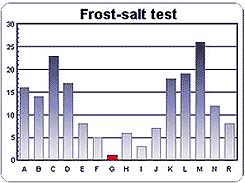|
Impregnation of concrete with CPES TM
Concrete is a very common construction material. It
is strong, easy to mould into different shapes and lasts
a long time. Concrete can stand high loads of pressure
but has a low tensile strength. It is therefore reinforced
with steel bars. The stress load can get much higher
than the tensile strength of the concrete, which will
cause small defects or cracks where the reinforcing
bars [rebar] take up the load.
Defects in the concrete can also be caused by incorrect
engineering, incorrect construction of forms, bad compacting
and curing, bad or insufficient reinforcement and deterioration
due to FREEZE-THAW DAMAGE.
Chlorides and carbonisation are the most usual reason
for corrosion in the reinforcement and the resulting
damages to the concrete. Too thin coatings, cracks in
the concrete, high temperatures, high moisture content
and oxygen will accelerate the rate of corrosion.
All national and international experience tells one
that all outdoor concrete structures should have a surface
protection. This way one will obtain an extended life
and also a more aesthetic appearance. A qualitative
surface protection is also a necessary protective measure
when doing repairs. A surface protection should prevent
water,
chlorides, oxygen and carbon dioxide from penetrating
the concrete. We have the best technology for achieving
this, and it has been proven by independent testing.
Impregnating concrete with CPES TM
Concrete deteriorates due to:
· Freeze-thaw damage
· Attack by chlorides
· Carbonisation
Impregnation should have the following
properties in order to prevent deterioration.
· Sufficient mechanical and chemical resistance
· Reduction of water- and gas absorption

The graph shows the average percent volume
loss of the test specimens due to freeze-thaw damage
after 10, 25, 50, 75 and 100 cycles of freezing and
thawing. The Ref column on the far right is untreated
concrete. The middle column, the one virtually zero,
is treated with CPES. This test is one of five different
tests done. The other tests
measured water- and vapour-diffusion, penetration of
chlorides, the effect of carbonisation and the depth
of penetration of the impregnation. CPES proved to be
dramatically superior in each one of these tests.
|